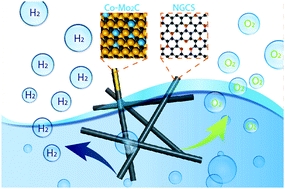Direct synthesis of bifunctional nanorods from a Co–adenine–MoO3 hybrid for overall water splitting†
Abstract
Transition-metal carbides have been proven to be efficient catalysts for the hydrogen evolution reaction (HER); however, their application as a bifunctional electrocatalyst towards the HER and oxygen evolution reaction (OER) altogether remains a significant challenge. Herein, we report unique heterostructures comprising cobalt-doped molybdenum-carbide (Co-Mo2C) nanorods encapsulated in nitrogen-doped graphitic carbon shell (NGCS) through one-step pyrolysis of a Co–adenine–MoO3 hybrid. The as-synthesized Co-Mo2C@NGCS heterostructures could be directly used as a catalyst for overall water splitting. Low overpotentials of 161 and 360 mV are needed for the HER and OER to reach 10 mA cm−2, and the corresponding Tafel slopes are just 60 and 54 mV dec−1, respectively. Theoretical simulations implied that the synergistic effects between the cobalt heteroatoms, NGCS and Mo2C resulted in the enhanced catalytic performance. Our work not only provides a facile method to construct hybrid electrocatalysts with inexpensive metals, but also gives new insights into the mechanism of the HER and OER in alkaline media.



 Please wait while we load your content...
Please wait while we load your content...